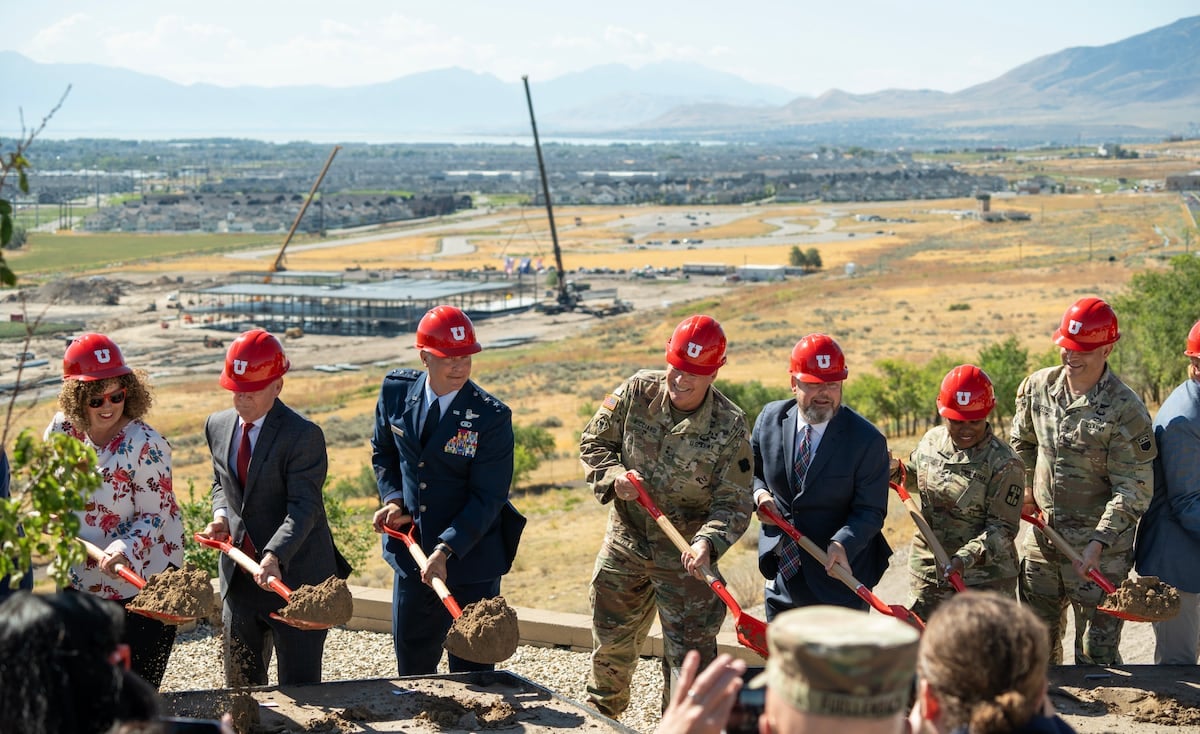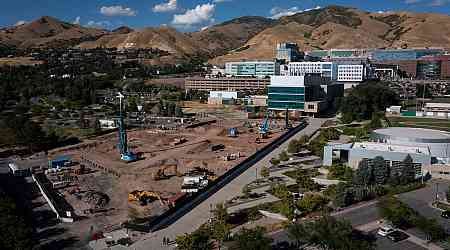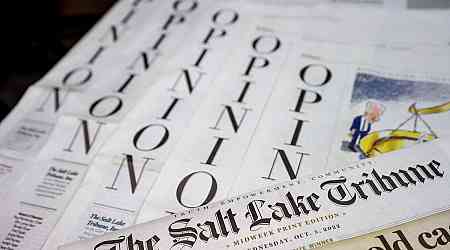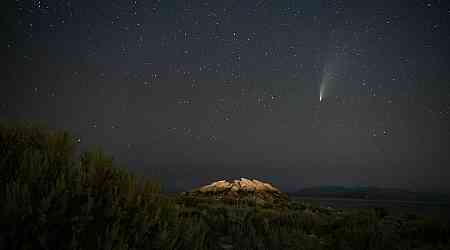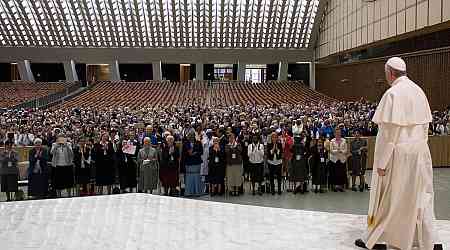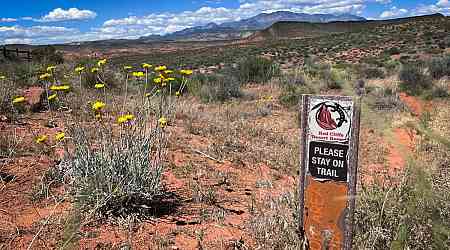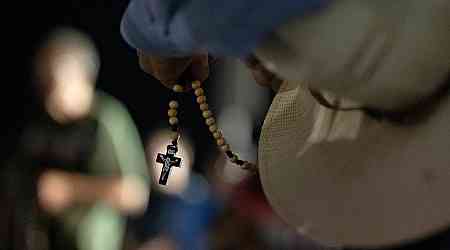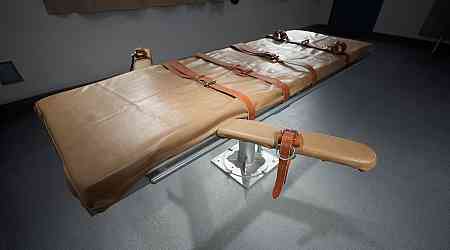Camp Williams • It took 14 years of intense negotiations, $117 million in state funding, agreements with multiple branches of the military and, according to University of Utah President Taylor Randall, two incredibly pivotal Diet Cokes to get to this day.
“This,” he said with a smile, “is certainly a significant milestone.”
Randall turned back to point out what he was talking about. At the bottom of the grassy hill below the stage where he spoke was a big piece of the project that has come out of that labor: The initial metal framing for a new building here at Camp Williams, which currently serves as the training site for the Utah National Guard.
Members of the audience leaned in their folding chairs to take a look at the bulldozers that were working even as the ceremonial groundbreaking was happening above them Monday morning in the bright sunshine. From one of the cranes, a red University of Utah flag whipped in the wind, twirling up with the stars and stripes of the American flag next to it.
With the additional building at Camp Williams, one of the biggest military sites in Utah will get even bigger. And it will now house and train soldiers in the Army Reserve, too, meaning there will be two forces at the location in Bluffdale.
And that is just one part of the complex and significant land swap announced Monday that required university, state, federal and military sign-off.
The Utah Legislature allocated $17 million to purchase that land at Camp Williams and another $100 million to construct the state-of-the-art building for modernized military training. In exchange, the Army Reserve agreed to move there and vacate its outdated facilities sitting on the last 50 acres it had been holding onto at the east end of the U.’s campus at Fort Douglas.
That means — for the first time since 1862 when the fort originally opened as a camp ordered by then-President Abraham Lincoln — there will not be a military presence at or near the University of Utah.
Once the Army Reserve units transfer out of Fort Douglas, which is expected in 2026, the U. will then own the coveted land at the center of its ballooning but land-locked campus, giving it additional space to grow in a competitive real estate market.
(The U. has recently been buying more property in downtown Salt Lake City — a sign of the limited options it has for expansion on its main campus.)
Currently, Randall says the U. is considering building new student housing with the additional acreage — with the space sitting adjacent to the existing dorms on campus. But it could also be used for research, which would make it the new north end of Research Park. Or it might be turned into health science offices and clinics, putting those within walking distance of University Hospital.
Fort Douglas used to be much larger, covering 10,500 acres and housing 50,000 military personnel at its peak. But over time it has shrunk, and the university has grown in around it. Now, the remaining Army Reserve headquarters along Mario Capecchi Drive sit fenced off at the heart of so much of the school’s operations.
“The transfer allows us to dream big about our campus,” Randall said. “We do not underestimate or under-appreciate [it].”
The faces in the crowd looking back at him were state dignitaries, members of Utah’s congressional delegation, military generals and officers, and members of the National Guard in their camouflage uniforms.

How the deal took shape
On Monday, 15 leaders put on hard hats and plunged shovels into the dirt above the construction site to mark the occasion that had been a long time coming.
The efforts to get to the swap have been ongoing since 2010 — at least. Some point even further back, to a bill passed in the 1990s that required the Army Reserve to give its land there to the U. if it ever fully moved out of Fort Douglas. In that same decade, the military handed over some property to the school, which the U. used to later house Olympic athletes during the 2002 games in Salt Lake City.
It was only in the last two years, though, that the dreamed of deal started to see any real movement.
Jason Perry, the U.’s vice president for government relations, said he didn’t realize just how much of an undertaking it would be when he brought up the idea to acquire the Fort Douglas property 14 years ago during an annual development meeting.
He continued to bring it up each year, he said, and many helped fight for it, including a push the entire duration from retired Maj. Gen. Peter Cooke. But it never seemed to move forward much, battling against moving pieces and a mix of approvals.
Either Utah leaders would be on board, but the military wouldn’t. Or the Army Reserve would be fine with the deal, but state lawmakers had then backed off. Or someone at the university thought it wasn’t worthwhile. And for a long time, no one knew where the money would come from.
“We just didn’t have the resources,” said Stephen Sullivan, the director overseeing installations for the Army Reserve.
There are several divisions currently at Fort Douglas, including command, readiness and medical response soldiers. Overall, Sullivan said, 2,300 full-time and part-time staff work and live there, along with their families. And hefty military vehicles fill the parking lots. It’s a lot to pick up and move.
A cost-benefit analysis conducted by the Army Reserve at the request of the U.S. Senate, Sullivan said, found that moving from Fort Douglas would be more cost-effective because of the old structures there. But that didn’t necessarily point to a place for relocation or provide the funding for a new building.
Perry said it wasn’t until Randall took the helm of the university in 2022 that the project was given “more than a doubtful eye” by the school’s administration.

Randall said he doesn’t think he had that big of a role — except when it came to one conversation had over Utah’s unofficial favorite soda.
The president said there had been talk about the land next to Camp Williams as a spot proposed to relocate the Army Reserve. But he hadn’t ever heard from the property owner or anyone who had talked to him directly. He wasn’t even sure if the land was an option or if anyone had asked.
So Randall decided to go rogue and knocked on his door one afternoon.
He brought U. Trustees Chair Christian Gardner, he recalled, and two Diet Cokes. And they had a chat with the owner about selling.
“There have been ups and downs and so many stories,” Randall said with a laugh. But it worked.
With the owner on board and a location determined, the Utah Legislature joined on and promised the initial $17 million during the 2022 legislative session to purchase the land. The funding meant the military was then ready to take a step forward.
Sullivan said there were still some reservations when Randall presented the plan in 2023 at the Pentagon. But after the state showed how the new building would meet the Army Reserve’s needs within the budget, the force was engaged.
Lawmakers then set aside the rest to cover the construction.
“$100 million is a great investment,” said Utah Senate President Stuart Adams. “But it’s an investment in our future.”
Fort Douglas’ history
The University of Utah and Fort Douglas have a long, shared history. Intertwined through that, and at Camp Williams, too, is the legacy of the original Native peoples of this land that is also being navigated as the projects at both locations move forward.
The U. first opened its doors in 1850. The fort, initially a camp, started nearby 12 years later during the Civil War.

The main reason the U.S. government wanted a fort in the territory was to guard the mail system that ran through the area because the frontier soldiers who had been protecting it were called home to fight. Another prominent motivation was to keep an eye on Latter-day Saint leaders — particularly Brigham Young — for suspected radicalism after members of the faith settled here to avoid persecution and to live under their own laws.
Utah Lt. Gov. Deidre Henderson acknowledged that history during the announcement Monday, joking the irony is “not lost on me” that 162 years later the state and the military are now proudly partnering.
The first infantry stationed at the fort was largely made up of volunteers from California and led by Col. Patrick E. Connor.
In 1863, Connor launched a punitive attack on the Shoshone Tribe for allegedly stealing from white settlers and miners. His infantry traveled north to the border of what is now Idaho, where they killed at least 300 Indigenous people. It is referred to as the Bear River Massacre and is considered one of the worst attacks on Natives in the history of the United States.
The land where that massacre occurred has since been purchased by the Northwestern Band of the Shoshone Nation for a memorial. Meanwhile, at Fort Douglas, a statue of Connor remains standing. It is unclear if the U. will now address complaints about that, with its ownership.
At this point, the school has committed only to preserving the military history at the fort, with a campus planner already assigned to the task, Randall said. It has not released specifics on what that will look like.
Taking over the 50 acres, though, will not affect the existing military cemetery; that land, about 110 acres, was already transferred from the Army Reserve to state ownership years back.

It is not clear yet, though, if the move will impact the operation of the historic chapel or the Fort Douglas Museum. Those may be designated as part of the preservation effort.
Adams said he is excited to see what the U. does to honor the presence of both the Army soldiers and the National Guard members who served there (before it was later converted only for Army Reserve forces). His father, he noted, was one of those soldiers, so it’s personal for him.
His father served in World War II, training troops on jungle warfare, Adams said. After that, he returned to Utah and joined the Army Reserve at Fort Douglas. Adams remembers listening to the stories his dad would tell about war and some of his later experiences which included mention of that space as a special home.
“The fort was not just a place of preparation, it was a place of transformation where ordinary citizens became extraordinary soldiers ready to serve their nation in a time of need,” added Utah National Guard Adjutant General Daniel Boyack.
Utah was granted statehood in 1896, and shortly after, World War I started. Fort Douglas was expanded then to accommodate the training of additional troops to send overseas. A German prisoner of war camp was built there at the time and was used again during World War II. It housed 900 prisoners at its maximum.
That history is also complicated. Several German prisoners were buried at the Fort Douglas cemetery. At least one of the gravestones, that of Paul Eilert, features a swastika carved into it. That garnered attention in 2020, and Veterans Affairs promised at the time to remove it.
Fort Douglas is also known for having a Black regiment stationed there in 1898. That 24th Infantry was deployed to Cuba during the Spanish-American War and is often regarded for its bravery.
One group in Utah, the Sema Hadithi Foundation, has worked to preserve the history of those so-called Buffalo Soldiers, including documenting their names, telling their stories and creating a heritage trail with the Utah State Historic Preservation Office.
A bit of that history is currently included in the Fort Douglas Museum, though not as much as the foundation has uncovered.
By the end of World War II, the Army viewed Fort Douglas as surplus and parcels of land started being transferred to the U. as the military operations were scaled back; that includes the land that is now Research Park and the medical campus.
The flag was technically lowered on the fort in 1967, though the Reserve soldiers continued to work there on the last 50 acres.
A U. spokesperson said Monday the Reserve Officers’ Training Corps, or ROTC program, which is a college program that trains students to be commissioned officers, will continue at the university even without the military operations on campus.
The military’s future in Utah
Under the desert dirt where the new facility at Camp Williams is supposed to go, surveyors doing an impact study bumped into a history similar to Fort Douglas’. They found artifacts believed to be from the Shoshone people.
That meant it was an archaeological site eligible for the National Register of Historic Places, said Adjutant General Boyack.
Boyack said the military consulted with local tribal leaders, namely Brad Parry, the vice chairman of the Northwestern Band of the Shoshone Nation. Parry attended the announcement Monday and has provided guidance about the best course of action for the property.
The archaeological site, which is limited to about a 3-foot by 3-foot square, will not be built on. It is currently surrounded by black tarps as construction crews work on the nearby structure, which they broke ground on earlier this year.
Boyack said, in an agreement with tribal leaders, the Native site to the east of the building will be preserved. The plan is to keep it buried, but to mark it with a garden of Indigenous plants and a historical marker. Already, there is a historical sign acknowledging the tribe at the overlook where the announcement was made Monday.
“We respect the cultural heritage of the land,” he added.

Moving forward, too, Boyack said the Army Reserve and the Utah National Guard now have protocols for if Native sites are discovered during construction for any future expansions.
And Boyack hopes the new building ultimately does spur more interest and growth in the military in Utah. The facility itself, he said, will be equipped to train a “stronger and more prepared defense force.”
And he likes that the land has a past that will be honored while it also forges forward with a new mission. To him, it represents the Utah Guard’s motto: “Always Ready. Always There.”
“This move is much more than just a change in location,” he said, pointing at the construction.
As the ceremony ended and the 23rd Army Band played a triumphant tune, Boyack thought about how it may have taken a long time to get to this agreement, but he was already envisioning more than 14 years and many Diet Cokes into the future.
function onSignUp() { const token = grecaptcha.getResponse(); if (!token) { alert("Please verify the reCAPTCHA!"); } else { axios .post( "https://8c0ug47jei.execute-api.us-east-1.amazonaws.com/dev/newsletter/checkCaptcha", { token, env: "PROD", } ) .then(({ data: { message } }) => { console.log(message); if (message === "Human

















